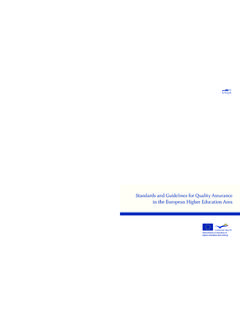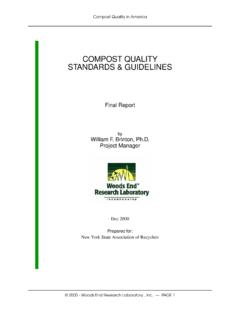Transcription of Quality of care - who.int
1 Quality of careA PROCESS FOR MAKING STRATEGIC CHOICES IN HEALTH SYSTEMSISBN 92 4 156324 9 This guide provides decision-makers and managers at country level with a systematic process which will allow them to design and implement effective interventions to promote Quality in health systems. It focuses particular attention on people who have a strategic responsibility for Quality so that they can cre-ate an enabling environment for all the Quality improvement initiatives being undertaken at the medical care level and rein-force their chances of success and sustainability. It has been designed to assist self-assessment and serve as a discussion guide so that decision-makers and interested parties in the Quality arena can work together on fi nding answers for their own setting. Quality of CareA process for making strategic choices in health systems WHO Library Cataloguing-in-Publication DataQuality of care : a process for making strategic choices in health assurance , Health care.
2 Services administration. making. I. World Health 92 4 156324 9 (NLM classifi cation: W )ISBN 978 92 4 156324 6 World Health Organization 2006 All rights reserved. Publications of the World Health Organization can be obtained from WHO Press, World Health Organization, 20 Avenue Appia, 1211 Geneva 27, Switzerland (tel.: +41 22 791 3264; fax: +41 22 791 4857; e-mail: Requests for permission to reproduce or translate WHO publications whether for sale or for noncommercial distribution should be addressed to WHO Press, at the above address (fax: +41 22 791 4806; e-mail: The designations employed and the presentation of the material in this publication do not imply the expres-sion of any opinion whatsoever on the part of the World Health Organization concerning the legal status of any country, territory, city or area or of its authorities, or concerning the delimitation of its frontiers or bound-aries.))
3 Dotted lines on maps represent approximate border lines for which there may not yet be full mention of specifi c companies or of certain manufacturers products does not imply that they are endorsed or recommended by the World Health Organization in preference to others of a similar nature that are not mentioned. Errors and omissions excepted, the names of proprietary products are distinguished by initial cap-ital reasonable precautions have been taken by the World Health Organization to verify the information con-tained in this publication. However, the published material is being distributed without warranty of any kind, either expressed or implied. The responsibility for the interpretation and use of the material lies with the read-er. In no event shall the World Health Organization be liable for damages arising from its use.
4 Printed in FranceContentsAcknowledgements .. vForeword ..viiStructure of the document .. 11. Background and assumptions .. 3 Why a focus on Quality now? .. 3 Why a focus on health systems and decision-makers? .. 3 Improving Quality and whole-system reform .. 5 Policy-making and evidence.. 62. Basic concepts of Quality .. 9 Defi nitions and the dimensions of Quality .. 9 Roles and responsibilities in Quality improvement..103. A process for building a strategy for Quality : choosing interventions ..13An overview of the suggested process..13 Analysis ..15 Element 1. Stakeholder involvement ..15 Element 2. Situational analysis ..16 Element 3. Confi rmation of health goals ..17 Building the strategy: Choosing inter ventions for Quality ..19 Element 4. Development of Quality goals ..19 Element 5. Choosing interventions for Quality .
5 20 Mapping the domains ..20 Linking the domains to the decision-making process ..25 Deciding on interventions..26 Implementation ..28 Element 6. Implementation process ..28 Element 7. Monitoring progress..29 ANNEX A: A self-assessment questionnaire for detailed analysis of Element 5 of the decision-making process ..31 ANNEX B: A matrix to map Quality interventions by roles and responsibilities in a health system ..37 vThe World Health Organization (WHO) expresses appreciation to all those who contributed to the production of this authors and project team:Rafael Bengoa and Rania Kawar, Department of Health System Policies and Operations, WHO, Geneva Peter Key, Dearden Consulting Limited, United Kingdom Sheila Leatherman, University of North Carolina, USA and Judge Business School, University of Cambridge, United Kingdom Rashad Massoud, Institute for Healthcare Improvement, Cambridge, MA, USAP edro Saturno, University of Murcia, core technical group included Ahmed Abdul Latif, Michael Adelhardt, Rebecca Bailey, Venkatraman Chandra-Mouli, Katie Edwards, Andrei Issakov, Rolf Korte, Itziar Larizgoitia, Hernan Montenegro, Anselm Schneider, Paul Van Ostenberg, Martin Weber, and Stuart input and advice were provided by Sandra Black, Alimata Diarra-Nama, Christine Dowse, Enrique Terol Garcia, Maimunah Hamid, Graham Harrison, Khaled Hassan.
6 Dale Huntington, Tom Mboya Okeyo, Hugo Mercer, Henock Alois Mayombo Ngonyani, Sue Page, Zinta Podniece, Sarah Prendergast, Osama Samawi, Maria Santos Ichaso, Tin Tin Sint, Sangay Thinley, Naruo Uehara, Mukund Uplekar, Orlando Urroz, Guillermo Williams, and Jelka Zupan. Administrative and secretarial support was provided by Margaret Inkoom and Melanie McCallum. Editing by Creative PublicationsGraphic design and layout: In s ( ) Acknowledgements viiThis document provides decision-makers and managers at country level with a systematic process which will allow them to design and implement effective interventions to promote Quality in health as a capacity-building tool in health-care Quality , this guide focus-es particular attention on people who have a strategic responsibility for qual-ity.
7 The reason for this approach is the understanding that in most countries there is an enormous amount of local readiness and action for Quality improve-ment but frequently this action is carried out in an insuffi cient policy and strate-gic environment. Furthermore, the process suggested here will help managers and decision- makers decide on which components of Quality they wish to focus. In some coun-tries, there may be more leverage for Quality in reorganizing the delivery of care across settings, while in others it may be more appropriate to start with patient-safety activities. The intention, therefore, has been to keep the process simple and to avoid suggesting that one size fi ts all and that there are magic bullets for Quality . The guide also assumes that a common process of decision-making for policy-makers has relevance for the vast majority of countries, regardless of their par-ticular circumstances.
8 This assumption is made on the grounds that a robust process of decision-making will take into account country-specifi c factors such as current resourcing, cultural sensitivity, affordability, and sustainabil-ity in determining which combination of Quality interventions will deliver the best outcomes and benefi ts for a country. The principles of Quality manage-ment are largely identical across all countries, as they build on optimal use of scarce resources, client orientation, and sound planning, as well as evidence for improved Quality of these commonalities across all countries, capacity-building in low- and middle-income countries has some specifi cities since it operates in a highly dynamic development context. During past decades, support to low- and mid-dle-income countries has been driven by a supplier mentality.
9 The focus was on the transfer of fi nancial and physical resources and technology, with the Forewordviiiassumption that this would trigger improvement. In many ways this supply-led logic continues to dominate in Quality improvement with a wide array of ready-made methods and brands being recommended to receptive health sys-tems in low- and middle-income nations. Although many of these Quality brands are very useful improvement approaches, this document is conceived to support countries in developing their own comprehensive strategies for Quality before deciding to use specifi c branded approaches developed in other regions. Recognizing the need to build capacity within countries, this guide has been designed to assist self-assessment and serve as a discussion guide so that deci-sion-makers and interested parties in the Quality arena can work together on fi nding answers for their own setting.
10 The role of donors, development agen-cies, and/or consultant groups will be to support the implementation of these country-specifi c designs not to substitute for them. Rafael BengoaWorld Health Organization, Geneva2006 Foreword1 This guide is divided into the following four 1, Background and assumptions, presents the context and rationale for developing this 2, Basic concepts in Quality , provides simple working defi nitions of what is meant by Quality in the context of health and health care, and describes various roles and responsibilities which apply to Quality improve-ment in any health 3, A process for building a strategy for Quality : choosing interventions, describes a decision-making process for policy-makers, which includes seven elements related to initial analysis, strategy development, and implementa-tion.
















